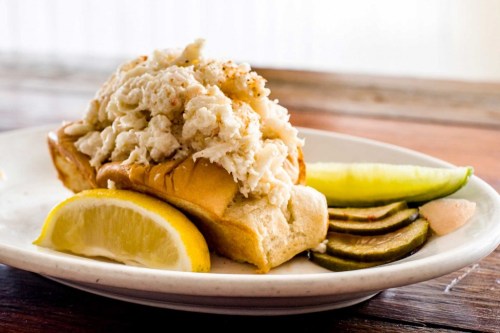 There is a dish you can eat in a cellar in Brooklyn that is a work of art, and also soulful. It costs $12, and will fill you up.
There is a dish you can eat in a cellar in Brooklyn that is a work of art, and also soulful. It costs $12, and will fill you up.
That dish is Mekelburg’s salt-baked potato with crème fraîche, black caviar, and smoked black cod.
You may think it’s not for you because caviar is a token of luxury, in a city where you finally understand you cannot afford luxury. You may assume the roe must be inferior and the dish somehow a sham, because the really good stuff wouldn’t cost $12, not even as a dollop on top of a potato. Ignore your thoughts, though, and just eat the thing: a huge potato completely covering a small plate, with unctuous, salty bits of smoked fish around it (and, you will discover, thoroughly veined in a little network inside it, like eggs or seeds).
That fish is smoked sable, what “black cod” is called when it’s at home. Ashkenazi Jews of a certain age know sable as the best thing to put on a bagel, so much better than lox it’s not funny. On top of the potato is a creamy mound of crème fraîche with a huge load of unusually buttery, unsalty, even fruity-tasting caviar on it. There is softened butter with dill (and more bits of sable) around the edges of the plate. Together, the potato and sable and only-slightly-sour cream and caviar make up a food that mixes Jewish and Gentile, the feeling of being cared for by one’s mother and the delights you can get when you go out on your own into the world. How that plate brought together salt, sweet, fat, sophisticated, homey almost made me cry.
It’s an odd time for eating out in New York. The places most likely to be reviewed by critics are restaurants where entrées cost $30 and tasting menus cost $100 and more. They are tiny food-temples and shiny mega-boîtes where most of us can’t go even if, by normal US standards, we are “upper income” — little palaces where, we, reader, certainly can’t eat if we are what the government calls either low income or middle-class. (Note that $55,575 is the median household income in the United States; median household income in the city is $67,201.) Reading the reviews has become an exercise in tantalized frustration: breathing in paragon writer Pete Wells’ description, in the New York Times, of the grated frozen foie gras appetizer at Momofuko Ko, you could be forgiven for feeling like the orphan cousin not invited to the party. “A cook behind the counter would rub a frozen cured brick of it across a Microplane held above a bowl with pine nut brittle, riesling jelly and lobes of lychee, showering them with falling pink flakes of airborne pleasure.” (The liver is part of the $195 tasting menu for lunch or dinner, the only way that you can eat at Ko.) The other spots in critics’ reviews – restaurants like Cosme and Blue Hill and even Contra and The Spotted Pig — are not for us, either, unless we’re in the top 5%, or interested in acquiring a load of debt that will cripple us.
Continue reading “Caviar for the 99%”





